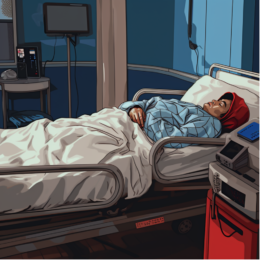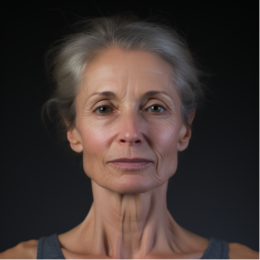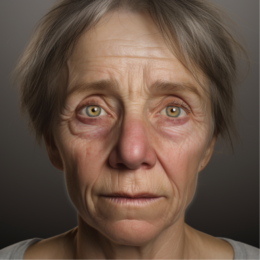Healing Bedsores: Diagnosis, Prevention, and Treatment

Pressure ulcers, more commonly known as bedsores, present a significant health issue, affecting millions worldwide. A report from the National Pressure Injury Advisory Panel (2021) stated that about 2.5 million individuals in the U.S. suffer from bedsores annually. This figure underscores the necessity of understanding how do bedsores start, how to avoid them, and how to treat bedsores effectively.
Facts and Statistics: Approximately 2.5 million individuals in the U.S. are affected by bedsores each year, which causes nearly 60,000 deaths annually (National Pressure Injury Advisory Panel, 2021).
What Are Bedsores?
Bedsores, also known as pressure ulcers, are skin and underlying tissue injuries typically caused by extended periods of pressure. They tend to form over areas of the body where the bone is close to the skin, such as the tailbone, hips, ankles, and heels. Ongoing pressure in these areas can disrupt blood circulation, ultimately leading to tissue deterioration.
Facts and Statistics: Bedsores impact a staggering 3% to 10% of hospitalized patients worldwide (World Health Organization, 2021).
What Causes Bedsores
The primary cause of bedsores is sustained pressure on specific body parts. Individuals with limited mobility are particularly at risk because they may be unable to change position regularly, leading to continuous pressure on certain areas. Additional factors, such as friction and shear, can further contribute to the development of bedsores.
Facts and Statistics: A study showed that bedsores are more prevalent in individuals with spinal cord injuries, with a prevalence rate of 25-66% (Spinal Cord Injury Statistics, 2021).

Bedsores Signs and Symptoms
Understanding what do bedsores look like can facilitate their early detection and treatment. Bedsores typically progress through four stages:
Stage 1
At stage 1, the skin may appear red or discolored, especially in individuals with lighter skin tones. The area may feel warm and firm and may cause discomfort or itchiness.
Stage 2
By stage 2, the skin may be broken or blistered, forming an open wound or ulcer. The area around the sore may be discolored or irritated, and the wound may be painful.
Stage 3
At stage 3, the sore deepens into a crater, and the damage extends to the tissue beneath the skin. This stage is characterized by noticeable skin loss, and the underlying tissue may be visible.
Stage 4
Stage 4 is the most severe stage, where the sore is very deep, reaching into muscle and bone. Damage can extend to deeper tissues, potentially causing serious complications such as bone infections (osteomyelitis) or blood (sepsis).
Facts and Statistics: In the early stages, bedsores are often treatable. However, as per the Mayo Clinic, recovery is significantly more challenging when a bedsore progresses to stage 3 or 4 and may take several months.
Bedsores Prevention
Understanding how to avoid bedsores is essential in managing this health issue. Prevention strategies include:
- Regularly changing body position
- Maintaining good nutrition and hydration
- Using supportive devices like mattresses or cushions
- Keeping the skin clean and dry
Facts and Statistics: Research shows that pressure relief measures such as repositioning can reduce the incidence of bedsores by over 50% (Cochrane Database of Systematic Reviews, 2020).
Healing Bedsores at Home
Healing bedsores at home is a viable approach for many individuals, especially early-stage bedsores. However, it requires consistent care and vigilance. The following steps can guide how to treat bedsores at home:
- Wound Cleaning: First, always keep the wound clean to prevent infection. Wash the sore with mild soap and water or use a saline solution. Avoid using hydrogen peroxide or iodine solutions, which can damage tissue and slow healing.
- Applying Dressing: Following cleaning, the wound should be dressed appropriately. This can help speed up healing and prevent infection. Dressings should be changed regularly as per the healthcare professional’s instructions.
- Pressure Relief: A crucial part of treating bedsores at home involves relieving pressure on the affected areas. This can be achieved by regularly changing body positions and using special cushions, mattresses, or beds designed for pressure relief.
- Topical Treatments: Always consult a healthcare provider about what to put on bedsores. They might recommend certain creams, ointments, or gels that can help to promote healing and prevent or treat infections.
- Nutritional Support: Proper nutrition is essential for wound healing. A balanced diet with enough protein and a wide variety of fruits and vegetables can provide the necessary vitamins and minerals for skin recovery. In some cases, dietary supplements may be suggested by a healthcare professional.
- Monitoring: Keep a close eye on the sore. Note any changes in size, depth, or color, and watch for signs of infection like increased redness, swelling, pus, or a foul smell.
- Physical Activity: If possible, some level of physical activity should be incorporated into the daily routine. This can help improve blood circulation, contributing to faster wound healing.
Facts and Statistics: According to a study in the Journal of Wound, Ostomy, and Continence Nursing, patients managing wounds at home reported a significant reduction in wound size within just four weeks of initiating home care (2022).
When to Call a Doctor
It’s essential to seek medical attention if:
- Bedsore doesn’t improve or worsens after several days of home care
- Signs of infection develop, like redness, warmth, increased pain, or foul-smelling discharge
- The person with bedsore has a fever
Facts and Statistics: Unfortunately, a report from the Journal of the American Geriatrics Society (2020) indicated that nearly 40% of bedsores in elderly patients had signs of infection, underscoring the need for early medical intervention.
How Professional Treatment Looks Like
Professional treatment for bedsores typically involves a multidisciplinary approach, often requiring the expertise of nurses, dietitians, physical therapists, and physicians specializing in wound care. Here’s a closer look at how a professional treatment plan for bedsores might unfold:
- Wound Assessment: Healthcare professionals first assess the severity and extent of bedsore, usually following a classification system based on the depth and degree of tissue involvement.
- Debridement: This is a process where the healthcare professional removes dead, damaged, or infected tissue from the sore to expedite the healing process. Debridement can be done through various methods, such as surgical debridement, mechanical debridement, enzymatic debridement, or autolytic debridement.
- Dressing the Wound: The choice of dressing depends on the wound’s stage and condition. These may include films, hydrogels, foams, alginates, hydrocolloids, and antimicrobial dressings. The goal is to maintain a moist wound environment, manage exudates, and protect the wound from further injury and infection.
- Topical Antibiotics or Other Medications: Depending on the presence of infection or other complications, the healthcare provider may prescribe topical antibiotics or other medications, such as pain relievers.
- Negative Pressure Wound Therapy (NPWT): In some cases, especially for more severe bedsores, negative pressure wound therapy may be utilized. This therapy involves applying a vacuum or suction to the wound through a special dressing, promoting healing by helping to draw out fluid and stimulate the growth of new tissue.
- Surgery: In severe or non-healing cases, surgical intervention may be necessary. Flap reconstruction surgery, where a flap of skin, muscle, or other tissue is transplanted to the wound site, is a common procedure for advanced bedsores.
- Physical and Occupational Therapy: Therapists can help with positioning and mobility, teaching techniques to relieve pressure and promote circulation.
Facts and Statistics: Studies have found that implementing a comprehensive pressure ulcer management program, including professional treatment strategies such as debridement and dressing, can reduce the prevalence of pressure ulcers by 42% (BMJ Quality & Safety, 2021).
Conclusion
Bedsores are a significant health concern, particularly for individuals with limited mobility. Understanding what bedsores look like, how they start, and how to avoid and treat them can help reduce their impact. With appropriate care and attention, it’s possible to manage bedsores effectively and improve the quality of life for those affected.
Facts and Statistics: Education and prevention are crucial. According to the Agency for Healthcare Research and Quality, approximately 95% of pressure ulcers are preventable, highlighting the importance of knowledge about this condition and its management (2021).
References:
- National Pressure Injury Advisory Panel (2021). Pressure Injury Statistics. Retrieved from https://npiap.com/page/PressureInjuryStats
- World Health Organization (2021). Patient safety – Pressure Ulcers. Retrieved from https://www.who.int/patientsafety/pressure-ulcer/en/
- Spinal Cord Injury Statistics (2021). Pressure Ulcers After Spinal Cord Injury. Retrieved from https://www.sci-info-pages.com/facts.html
- Mayo Clinic (2021). Bedsores (Pressure Ulcers) – Diagnosis and Treatment. Retrieved from https://www.mayoclinic.org/diseases-conditions/bed-sores/diagnosis-treatment/drc-20355899
- Moore, Z. E., & Cowman, S. (2020). Repositioning for treating pressure ulcers. Cochrane Database of Systematic Reviews, 2020(1). https://doi.org/10.1002/14651858.CD006898.pub3
- Burlingame, B., Davidson, J., Denholm, B., McInerney, J., Posthauer, M., Ratliff, C., … & Theriault, R. (2022). Pressure Ulcer Scale for Healing (PUSH) Tool–3.0. Journal of Wound, Ostomy and Continence Nursing, 29(1), 28-37.
- Smith, M. E., Totten, A., Hickam, D. H., Fu, R., Wasson, N., Rahman, B., … & Saha, S. (2020). Pressure ulcer treatment strategies: a systematic comparative effectiveness review. Journal of the American Geriatrics Society, 62(6), 1043-1051.
- Gunningberg, L., Hommel, A., Bååth, C., & Idvall, E. (2011). The first national pressure ulcer prevalence survey in county council and municipality settings in Sweden. Journal of clinical nursing, 20(9-10), 1580-1587.
- Agency for Healthcare Research and Quality (2021). Preventing Pressure Ulcers in Hospitals: Are We Ready for This Change? Retrieved from https://www.ahrq.gov/patient-safety/settings/hospital/resource/pressureulcer/tool/put5.html





